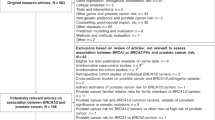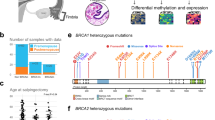Abstract
The BRCA1 mutation c.5266dupC was originally described as a founder mutation in the Ashkenazi Jewish (AJ) population. However, this mutation is also present at appreciable frequency in several European countries, which raises intriguing questions about the origins of the mutation. We genotyped 245 carrier families from 14 different population groups (Russian, Latvian, Ukrainian, Czech, Slovak, Polish, Danish, Dutch, French, German, Italian, Greek, Brazilian and AJ) for seven microsatellite markers and confirmed that all mutation carriers share a common haplotype from a single founder individual. Using a maximum likelihood method that allows for both recombination and mutational events of marker loci, we estimated that the mutation arose some 1800 years ago in either Scandinavia or what is now northern Russia and subsequently spread to the various populations we genotyped during the following centuries, including the AJ population. Age estimates and the molecular evolution profile of the most common linked haplotype in the carrier populations studied further suggest that c.5266dupC likely entered the AJ gene pool in Poland approximately 400–500 years ago. Our results illustrate that (1) BRCA1 c.5266dupC originated from a single common ancestor and was a common European mutation long before becoming an AJ founder mutation and (2) the mutation is likely present in many additional European countries where genetic screening of BRCA1 may not yet be common practice.
Similar content being viewed by others
Log in or create a free account to read this content
Gain free access to this article, as well as selected content from this journal and more on nature.com
or
References
Narod SA, Foulkes WD : BRCA1 and BRCA2: 1994 and beyond. Nat Rev Cancer 2004; 4: 665–676.
National Human Genome Research Institute, NIH: Breast Cancer Information Core Database. National Human Genome Research Institute, NIH, 2009. Accessed 10 February 2010; http://research.nhgri.nih.gov/bic/.
Struewing JP, Abeliovich D, Peretz T et al: The carrier frequency of the BRCA1 185delAG mutation is approximately 1 percent in Ashkenazi Jewish individuals. Nat Genet 1995; 11: 198–200.
Ah Mew N, Hamel N, Galvez M, Al-Saffar M, Foulkes WD : Haplotype analysis of a BRCA1: 185delAG mutation in a Chilean family supports its Ashkenazi origins. Clin Genet 2002; 62: 151–156.
Roa BB, Boyd AA, Volcik K, Richards CS : Ashkenazi Jewish population frequencies for common mutations in BRCA1 and BRCA2. Nat Genet 1996; 14: 185–187.
Neuhausen SL, Mazoyer S, Friedman L et al: Haplotype and phenotype analysis of six recurrent BRCA1 mutations in 61 families: results of an international study. Am J Hum Genet 1996; 58: 271–280.
Neuhausen SL, Godwin AK, Gershoni-Baruch R et al: Haplotype and phenotype analysis of nine recurrent BRCA2 mutations in 111 families: results of an international study. Am J Hum Genet 1998; 62: 1381–1388.
Kong A, Gudbjartsson DF, Sainz J et al: A high-resolution recombination map of the human genome. Nat Genet 2002; 31: 241–247.
Liu X, Barker DF : Evidence for effective suppression of recombination in the chromosome 17q21 segment spanning RNU2-BRCA1. Am J Hum Genet 1999; 64: 1427–1439.
Weber JL, Wong C : Mutation of human short tandem repeats. Hum Mol Genet 1993; 2: 1123–1128.
Greenwood CM, Sun S, Veenstra J et al: How old is this mutation? – a study of three Ashkenazi Jewish founder mutations. BMC Genet 2010; 11: 39.
‘Slav’ in Encyclopædia Britannica: Encyclop ædia Britannica Online 2010. Accessed 14 June 2010; http://www.britannica.com/EBchecked/topic/548156/Slav.
Parmele MP : A Short History of Russia. Middlesex: The Echo Library, 2008.
Barford PM : The Early Slavs. Ithaca: Cornell University Press, 2001.
Viking Age Europe - 793-1050 In: Concise Atlas of World History Andromeda 1997. Accessed 4 May 2010; http://www.credoreference.com/entry/andawh/viking_age_europe_793_1050.
‘Vikings’ in Encyclopedia of the Middle Ages. André Vauchez (eds): Encyclopedia of the Middle Ages (e-reference edition). James Clarke & Co, 2001. Accessed 4 May 2010; http://www.oxfordreference.com/.
James Clarke & Co: Mathieu Arnoux ‘Normandy’ in Encyclopedia of the Middle Ages. André Vauchez (eds): Encyclopedia of the Middle Ages (e-reference edition). James Clarke & Co, 2001. Accessed 4 May 2010; http://www.oxfordreference.com/.
‘Norman Conquest’ in World Encyclopedia. Oxford Reference Online 2008. Accessed 4 May 2010; http://www.oxfordreference.com/views/ENTRY.html?subview=Main&entry=t142.e8198.
Tonin PN : [The limited spectrum of pathogenic BRCA1 and BRCA2 mutations in the French Canadian breast and breast-ovarian cancer families, a founder population of Quebec, Canada]. Bull Cancer 2006; 93: 841–846.
Dubnow SN : History of the Jews in Russia and Poland; Translated from Russian by Friedlander, I. Bergenfield: Avotaynu Inc., 2000, vol 1.
Soegaard M, Kjaer SK, Cox M et al: BRCA1 and BRCA2 mutation prevalence and clinical characteristics of a population-based series of ovarian cancer cases from Denmark. Clin Cancer Res 2008; 14: 3761–3767.
Malander S, Ridderheim M, Masback A et al: One in 10 ovarian cancer patients carry germ line BRCA1 or BRCA2 mutations: results of a prospective study in Southern Sweden. Eur J Cancer 2004; 40: 422–428.
Sorlie T, Andersen TI, Bukholm I, Borresen-Dale AL : Mutation screening of BRCA1 using PTT and LOH analysis at 17q21 in breast carcinomas from familial and non-familial cases. Breast Cancer Res Treat 1998; 48: 259–264.
Papelard H, de Bock GH, van ER et al: Prevalence of BRCA1 in a hospital-based population of Dutch breast cancer patients. Br J Cancer 2000; 83: 719–724.
Suspitsin EN, Sherina NY, Ponomariova DN et al: High frequency of BRCA1, but not CHEK2 or NBS1 (NBN), founder mutations in Russian ovarian cancer patients. Hered Cancer Clin Pract 2009; 7: 5.
Bermisheva MA, Zinnamullina GF, Gantsev S et al: [Frequency of 5382insC mutation of the BRCA1 gene]. Vopr Onkol 2008; 54: 31–33.
Smirnova TY, Pospekhova NI, Lyubchenko LN et al: High incidence of mutations in BRCA1 and BRCA2 genes in ovarian cancer. Bull Exp Biol Med 2007; 144: 83–85.
Jasinska A, Krzyzosiak WJ : Prevalence of BRCA1 founder mutations in western Poland. Hum Mutat 2001; 17: 75.
Menkiszak J, Gronwald J, Gorski B et al: Hereditary ovarian cancer in Poland. Int J Cancer 2003; 106: 942–945.
Gorski B, Cybulski C, Huzarski T et al: Breast cancer predisposing alleles in Poland. Breast Cancer Res Treat 2005; 92: 19–24.
Romanowicz-Makowska H, Smolarz B, Zadrozny M, Kulig A : Analysis of RAD51 polymorphism and BRCA1 mutations in Polish women with breast cancer. Exp Oncol 2006; 28: 156–159.
Csokay B, Tihomirova L, Stengrevics A, Sinicka O, Olah E : Strong founder effects in BRCA1 mutation carrier breast cancer patients from Latvia. Mutation in brief no. 258. Online. Hum Mutat 1999; 14: 92.
Janavicius R, Pepalyte I, Kucinskas V : Novel and common BRCA1 mutations in familial breast/ovarian cancer patients from Lithuania. Breast Cancer Res Treat 2009; 117: 467–469.
Zikan M, Pohlreich P, Stribrna J : Mutational analysis of the BRCA1 gene in 30 Czech ovarian cancer patients. J Genet 2005; 84: 63–67.
Backe J, Hofferbert S, Skawran B et al: Frequency of BRCA1 mutation 5382insC in German breast cancer patients. Gynecol Oncol 1999; 72: 402–406.
van der Looij M, Szabo C, Besznyak I et al: Prevalence of founder BRCA1 and BRCA2 mutations among breast and ovarian cancer patients in Hungary. Int J Cancer 2000; 86: 737–740.
Armaou S, Pertesi M, Fostira F et al: Contribution of BRCA1 germ-line mutations to breast cancer in Greece: a hospital-based study of 987 unselected breast cancer cases. Br J Cancer 2009; 101: 32–37.
Kataki A, Gomatos I, Pararas N et al: Identification of germline BRCA1 and BRCA2 genetic alterations in Greek breast cancer moderate-risk and low-risk individuals – correlation with clinicopathological data. Clin Genet 2005; 67: 322–329.
Yazici H, Glendon G, Yazici H et al: BRCA1 and BRCA2 mutations in Turkish familial and non-familial ovarian cancer patients: a high incidence of mutations in non-familial cases. Hum Mutat 2002; 20: 28–34.
Manguoglu AE, Luleci G, Ozcelik T et al: Germline mutations in the BRCA1 and BRCA2 genes in Turkish breast/ovarian cancer patients. Hum Mutat 2003; 21: 444–445.
Acknowledgements
We would like to thank Dr Graham R Taylor for providing us with frequency and distribution information for the c.5266dupC mutation in England. This work was supported in part by Susan G Komen for the Cure (NH, WDF), by the Hellenic Cooperative Oncology Group research grant and the Greek General Secretariat for Research and Technology (GSRT) program (DY), as well as by the Russian Federation for Basic Research (grant 10-04-92601) and the Federal Agency for Science and Innovations (contract 02.740.11.0780) (EI). Genetic testing in the Czech Republic was supported by an MZ0 MOU 2005 grant (LF). We would also like to thank the Neye foundation for financial support (TOVH).
Author information
Authors and Affiliations
Corresponding author
Ethics declarations
Competing interests
The authors declare no conflict of interest.
Additional information
Supplementary Information accompanies the paper on European Journal of Human Genetics website
Rights and permissions
About this article
Cite this article
Hamel, N., Feng, BJ., Foretova, L. et al. On the origin and diffusion of BRCA1 c.5266dupC (5382insC) in European populations. Eur J Hum Genet 19, 300–306 (2011). https://doi.org/10.1038/ejhg.2010.203
Received:
Revised:
Accepted:
Published:
Issue date:
DOI: https://doi.org/10.1038/ejhg.2010.203
Keywords
This article is cited by
-
Germline mutations in BRCA1 and BRCA2 among Brazilian women with ovarian cancer treated in the Public Health System
BMC Cancer (2024)
-
Targeted next-generation sequencing of 21 candidate genes in hereditary ovarian cancer patients from the Republic of Bashkortostan
Journal of Ovarian Research (2023)
-
Founder vs. non-founder BRCA1/2 pathogenic alleles: the analysis of Belarusian breast and ovarian cancer patients and review of other studies on ethnically homogenous populations
Familial Cancer (2023)
-
BRCA1 and BRCA2 germline mutation analysis from a cohort of 1267 patients at high risk for breast cancer in Brazil
Breast Cancer Research and Treatment (2023)
-
A case–control study of BRCA1 founder mutations 185delAG and 5382insC in a cohort of Egyptian ovarian cancer patients using pyrosequencing technique
Egyptian Journal of Medical Human Genetics (2022)



